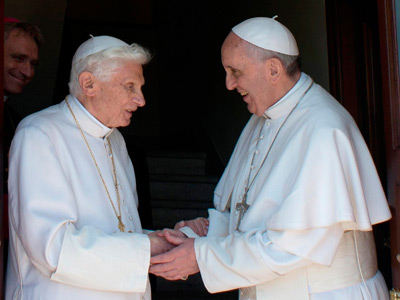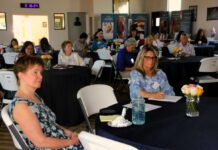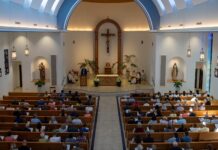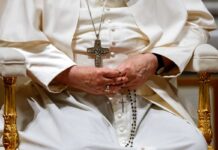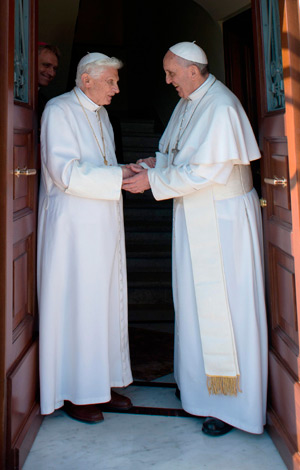
VATICAN CITY (CNS) — For the first time in history, the Vatican is home to a pope and a retired pope.
Pope Francis welcomed his predecessor, retired Pope Benedict XVI, to the Vatican May 2 outside the convent remodeled for the 86-year-old retired pontiff and five aides. Pope Francis and Pope Benedict entered the convent’s chapel together “for a brief moment of prayer,” said Jesuit Father Federico Lombardi, Vatican spokesman.
Pope Benedict had been staying at the papal summer villa in Castel Gandolfo since retiring Feb. 28. Pope Francis traveled to the villa 10 days after his election to visit, pray and have lunch with Pope Benedict; the new pope also has telephoned his predecessor on at least two occasions.
In response to questions about the fact that Pope Benedict seemed to be much frailer than he was two months ago, Father Lombardi told reporters, “He’s an elderly man, weakened by age, but he is not suffering from any illness.”
In the last year of his pontificate, Pope Benedict was seen walking with a cane on more and more public occasions; after Pope Benedict retired, Father Lombardi confirmed that he had had a pacemaker inserted before becoming pope in 2005 and had undergone a brief procedure in November to replace the battery.
While the Vatican is now home to a pope and his predecessor, neither lives in the papal apartments of the Apostolic Palace. Pope Francis continues to live in the Domus Sanctae Marthae, the Vatican guesthouse just south of St. Peter’s Basilica where the cardinals stayed during the conclave; the Mater Ecclesiae Monastery where Pope Benedict is living is just to the north of the basilica.
Arriving in Castel Gandolfo a couple hours before his retirement became official, Pope Benedict told a crowd gathered in the town square to welcome him, “I am a simple pilgrim who begins the last stage of his pilgrimage on this earth.
“With all my heart, with all my love, with my prayers, with my reflection, with all my interior strength, I still want to work for the common good and the good of the church and humanity,” he said, reaffirming his plans to spend his retirement in a “hidden life” of prayer and study.
The location he chose as his residence had served since 1994 as home to four different communities of cloistered nuns — Poor Clares, Carmelites, Benedictines and Visitandines — who each spent a five- or three-year term there in a life dedicated to praying for the pope and the church.
The structure includes what was once the Vatican gardener’s house; before the first group of nuns took up residence, Blessed John Paul II had it expanded to about 4,600 square feet, including a large chapel, refectory and infirmary.
Since the Visitandine nuns moved in November, the building has undergone a remodeling, including an expansion of the library specifically for Pope Benedict.
The retired pope will live in the Mater Ecclesiae Monastery with Archbishop Georg Ganswein, his secretary, who also serves Pope Francis as prefect of the papal household; and with four consecrated laywomen from Memores Domini, Father Lombardi said. The building also has a guestroom designed particularly for visits from Pope Benedict’s older brother, Msgr. Georg Ratzinger.
The Italian government helicopter bringing Pope Benedict to the Vatican from Castel Gandolfo was met at the Vatican heliport by Cardinal Tarcisio Bertone, Vatican secretary of state; Cardinal Angelo Sodano, dean of the College of Cardinals; and other officials from the Vatican governor’s office and the secretariat of state.
Waiting in St. Peter’s Square to see the helicopter arrive was a priest from Kenya, who did not want to give his name. He told Catholic News Service, “It’s good he (Pope Benedict) comes to pray for the new pope and everyone else. He teaches us how to pray.”
“I guess he didn’t want any fanfare,” the priest said, noting that the large video screens in St. Peter’s Square were blank and the Vatican Television Center did not provide images. A battery of TV cameras stood outside the square with the same hope of catching a glimpse of the helicopter.
Jenna Cooper of Cornwall, N.Y., who is studying at the Pontifical University of the Holy Cross in Rome, said she came to the square “because I love Pope Emeritus Benedict. I wanted to be here to offer my prayerful support. I wanted to witness this historic event.
“It’s a beautiful witness that he’s dedicating his life to prayer; it shows how important prayer is for the life of the church,” Cooper said.
Father Bryan Jerabek of the Diocese of Birmingham, Ala., also studying at Holy Cross, said he came to see the retired pope fly back and was hoping the Vatican would show video on the monitors, “but he asked to be hidden from the world” so perhaps he asked that there not be live coverage. “But it was nice to see the helicopter.”
As for having a pope and a retired pope living in the Vatican, Father Jerabek said: “It’s absolutely unprecedented. We’re all still trying to figure out what it means.”
Noting that Pope Francis has visited and phoned Pope Benedict, Father Jerabek said, “It’s obvious he wants to have a close relationship with his predecessor. And now he can take a 15-minute walk to see him.”
– – –
— By Cindy Wooden Catholic News Service. Contributing to this story was Carol Glatz at the Vatican.



